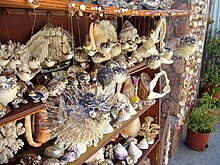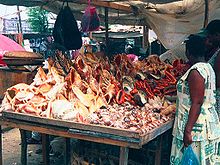Wildlife trade refers to the commerce of products that are derived from non-domesticated animals or plants
usually extracted from their natural environment or raised under
controlled conditions. It can involve the trade of living or dead
individuals, tissues such as skins, bones or meat, or other products.
Legal wildlife trade is regulated by the United Nations' Convention on International Trade in Endangered Species of Wild Fauna and Flora (CITES), which currently has 183 member countries called Parties. Illegal wildlife trade is widespread and constitutes one of the major illegal economic activities, comparable to the traffic of drugs and weapons. Wildlife trade is a serious conservation
problem, has a negative effect on the viability of many wildlife
populations and is one of the major threats to the survival of vertebrate species.
Terminology
Wildlife use is a general term for all uses of wildlife products, including ritual or religious uses, consumption of bushmeat and different forms of trade. Wildlife use is usually linked to hunting or poaching.
Wildlife trade can be differentiated in legal and illegal trade, and
both can have domestic (local or national) or international markets, but
they might be often related with each-other.
Ineffective monitoring of international wildlife trade
The volume of international trade in wildlife commodities is immense and continue to rise. According to an analysis to the 2012 Harmonized System
customs statistics, global import of wildlife products amounted to
US$187 billion, of which fisheries commodities accounted for $113
billion; plants and forestry products for $71 billion; non-fishery
animal for $3 billion including live animals, parts and derivatives.
However, the global trade of wildlife commodities is ineffectively monitored and accounted for due to the constraint of the HS Code
System used by the customs worldwide. The majority of international
imports of wildlife are only recorded in general categories such as
plant or animal products with no further taxonomic detail (this is akin
to importing metals without recording their element identity e.g. copper
or iron). It is estimated that near 50% of the global import of plant
and 70% of animals product are imported as general categories, with an
exception for fisheries (ca. 5%) thanks to various multilateral fishery
management agreements that requires taxon-specific fish catch reporting.
Many jurisdictions rely on the declared HS Code of the consignments for
detection and prosecution of illegal wildlife import. The lack of
specificity of HS code precludes effective monitoring and traceability
of global wildlife trade. There is an increasing call for a reform of
the Harmonized System to strengthen monitoring and enforcement of global
wildlife trade.
Reasons for concern
Different
forms of wildlife trade or use (utilization, hunting, trapping,
collection or over-exploitation) are the second major threat to
endangered mammals and it also ranks among the first ten threats to birds, amphibians and cycads.
Wildlife trade threatens the local ecosystem, and puts all species under additional pressure at a time when they are facing threats such as over-fishing, pollution, dredging, deforestation and other forms of habitat destruction. Wildlife is traded alive or dead.
In the food chain,
species higher up on the ladder ensure that the species below them do
not become too abundant (hence controlling the population of those below
them). Animals lower on the ladder are often non-carnivorous (but
instead herbivorous)
and control the abundance of plant species in a region. Due to the very
large amounts of species that are removed from the ecosystem, it is not
inconceivable that environmental problems will result, similar to e.g. overfishing, which causes an overabundance of jellyfish.
Survival rate of species during transport
In
some instances; such as the sale of chameleons from Madagascar,
organisms are transported by boat or via the air to consumers. The
survival rate of these is extremely poor (only 1% survival rate).
This is undoubtedly caused by the illegal nature; vendors rather not
risk that the chameleons were to be discovered and so do not ship them
in plain view. Due to the very low survival rate, it also means that far
higher amounts of organisms (in this case chameleons) are taken away
from the ecosystem, to make up for the losses.
Consequences for indigenous peoples
In many instances, tribal people have become the victims of the fallout from poaching.
With increased demand in the illegal wildlife trade, tribal people are
often direct victims of the measures implemented to protect wildlife.
Often reliant upon hunting for food, they are prevented from doing so,
and are frequently illegally evicted from their lands following the
creation of nature reserves aimed to protect animals.
Tribal people are often falsely accused of contributing to the decline
of species – in the case of India, for example, they bear the brunt of
anti-tiger poaching measures,
despite the main reason for the tiger population crash in the 20th
century being due to hunting by European colonists and Indian elites.
In fact, contrary to popular belief, there is strong evidence to show
that they effectively regulate and manage animal populations.
Illegal wildlife trade
Interpol
has estimated the extent of the illegal wildlife trade between $10
billion and $20 billion per year. While the trade is a global one, with
routes extending to every continent, conservationists say the problem is
most acute in Southeast Asia.
There, trade linkages to key markets in China, the United States, and
the European Union; lax law enforcement; weak border controls; and the
perception of high profit and low risk contribute to large-scale
commercial wildlife trafficking. The ASEAN Wildlife Enforcement Network (ASEAN-WEN) ASEAN Wildlife Enforcement Network, supported by the U.S. Agency for International Development and external funders, is one response to the region's illegal wildlife trade networks.
Asia
Notable trade hubs of the wildlife trade include Suvarnabhumi Airport in Bangkok, which offers smugglers direct jet service to Europe, the Middle East, North America and Africa. The Chatuchak weekend market
in Bangkok is a known center of illicit wildlife trade, and the sale of
lizards, primates, and other endangered species has been widely
documented. Trade routes connecting in Southeast Asia link Madagascar to
the United States (for the sale of turtles, lemurs, and other
primates), Cambodia to Japan (for the sale of slow lorises as pets), and the sale of many species to China.
Despite international and local laws designed to crack down on
the trade, live animals and animal parts — often those of endangered or
threatened species - are sold in open-air markets throughout Asia. The
animals involved in the trade end up as trophies, or in specialty
restaurants. Some are used in traditional Chinese medicine
(TCM). Despite the name, elements of TCM are widely adopted throughout
East and Southeast Asia, among both Chinese and non-Chinese communities.
The trade also includes demand for exotic pets especially birds, and consumption of wildlife for meat. Large volumes of fresh water tortoises and turtles, snakes, pangolins and monitor lizards are consumed as meat in Asia, including in specialty restaurants that feature wildlife as gourmet dining.
Related to the exotic pet trade, captive wildlife are held in
sanctuaries which have been involved in illegal wildlife trade. In
Thailand the Tiger Temple was closed in 2016 due to being accused of clandestine exchange of tigers.
Africa
Many African species are traded both within the country of origin and internationally. Charismatic mega-fauna are among commonly traded species native to the African continent including African elephants, pangolin, rhinoceros, leopards, and lions. Other animals such as vultures play a role in trade, both domestically and internationally.
Morocco has been identified as a transit country for wildlife
moving from Africa to Europe due to its porous borders with Spain.
Wildlife is present in the markets as photo props, sold for decoration,
used in medicinal practices, sold as pets and used to decorate shops.
Large numbers of reptiles are sold in the markets, especially
spur-thighed tortoises. Although leopards have most likely been
extirpated from Morocco, their skins can regularly be seen sold openly
as medicinal products or decoration in the markets.
South America
Although the volume of animals traded may be greater in Southeast Asia, animal trading in Latin America is widespread as well.
In open air Amazon markets in Iquitos and Manaus,
a variety of rainforest animals are sold openly as meat, such as
agoutis, peccaries, turtles, turtle eggs, walking catfish, etc. In
addition, many species are sold as pets. The keeping of parrots and
monkeys as pets by villagers along the Amazon is commonplace. But the
sale of these "companion" animals in open markets is rampant. Capturing
the baby tamarins, marmosets, spider monkeys, saki monkeys, etc., in
order to sell them, often requires shooting the mother primate out of a
treetop with her clinging child; the youngster may or may not survive
the fall. With the human population increasing, such practices have a
serious impact on the future prospects for many threatened species. The
United States is a popular destination for Amazonian rainforest
animals. They are smuggled across borders the same way illegal drugs
are - in the trunks of cars, in suitcases, in crates disguised as
something else.
In Venezuela
more than 400 animal species are involved in subsistence hunting,
domestic and international (illegal) trade. These activities are
widespread and might overlap in many regions, although they are driven
by different markets and target different species.
Online
Through both deep web (password protected, encrypted) and dark web
(special portal browsers) markets, participants can trade and transact
illegal substances, including wildlife. However the amount of activity
is still negligible compared to the amount on the open or surface web.
As stated in an examination of search engine key words relating to
wildlife trade in an article published by Conservation Biology,
"This negligible level of activity related to the illegal trade of
wildlife on the dark web relative to the open and increasing trade on
the surface web may indicate a lack of successful enforcement against
illegal wildlife trade on the surface web."
A study conducted by the International Fund for Animal Welfare (Ifaw) in 2018 revealed online sales of endangered wildlife (on the list of the global Convention on the International Trade in Endangered Species) was pervasive across Europe. Ivory accounted for almost 20 percent of the items offered.
Organizations addressing illegal wildlife trade
- ASEAN Wildlife Enforcement Network
- International Fund for Animal Welfare
- International Union for Conservation of Nature (IUCN)
- Clark R. Bavin National Fish and Wildlife Forensic Laboratory
- FREELAND Foundation
- South Asia Wildlife Enforcement Network (SAWEN)
- Species Survival Network
- TRAFFIC, the wildlife trade monitoring network
- Wildlife Alliance
- United for Wildlife
- United Nations Environment Programme
- World Wildlife Fund for Nature
Legal wildlife trade
Legal shipment of wildlife pelts, a form of legal wildlife trade
Legal trade of wildlife has occurred for many species for a number of
reasons, including commercial trade, pet trade as well as conservation
attempts. Whilst most examples of legal trade of wildlife are as a
result of large population numbers or pests, there is potential for the
use of legal trade to reduce illegal trade threatening many species.
Legalizing the trade of species can allow for more regulated harvesting
of animals and prevent illegal over-harvesting.
Many environmentalists, scientists, and zoologists around the
world are mostly against legalizing pet trade of invasive or introduced
species, as their release into the wild, be it intentional or not, could
compete with the indigenous species, can lead to its endangerment.
Examples of successful wildlife trade
Australia
Crocodiles
Trade of crocodiles in Australia has been largely successful. Saltwater crocodiles (Crocodylus porosus) and freshwater crocodiles (Crocodylus johnstoni) are listed under CITES Appendix II. Commercial harvesting of these crocodiles occurs in Northern Territory, Queensland and Western Australia,
including harvesting from wild populations as well as approved captive
breeding programs based on quotas set by the Australian government.
Kangaroos
Kangaroos are currently legally harvested for commercial trade and
export in Australia. There are a number of species included in the trade
including:
- Red kangaroo (Macropus rufus)
- Eastern grey kangaroo (M. giganteus)
- Western grey kangaroo (M.fuliginosus)
- Common wallaroo (M. robustus)
Harvesting of kangaroos for legal trade does not occur in National
Parks and is determined by quotas set by state government departments.
Active kangaroo management has gained a commercial value in the trade of
kangaroo meat, hides and other products.
North America
Alligator
Alligators have been traded commercially in Florida and other American states as part of a management program.
The use of legal trade and quotas have allowed management of a species
as well as economic incentive for sustaining habitat with greater
ecological benefits.
Legalising trade for endangered species
Under the Convention on International Trade of Endangered Species (CITES),
species listed under Appendix I are threatened with extinction, and
commercial trade in wild-caught specimens, or products derived from
them, is prohibited. This rule applies to all species threatened with
extinction, except in exceptional circumstances.
Commercial trade of endangered species listed under Appendix II and III
is not prohibited, although Parties must provide non-detriment finding
to show that the species in the wild is not being unsustainably
harvested for the purpose of trade. Specimens of Appendix I species that
were bred in captivity for commercial purposes are treated as Appendix
II. An example of this is captive-bred saltwater crocodiles, with some
wild populations listed in Appendix I and others in Appendix II.
Welfare in wildlife trade
Many
animals are kept for months in markets waiting to be sold. The welfare
of animals in trade is almost universally poor, with the vast majority
of animals failing to receive even the most basic freedom from pain,
hunger, distress, discomfort, and few opportunities to express normal
behaviour.
















